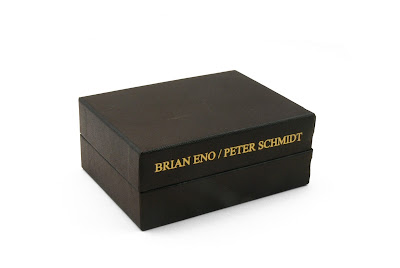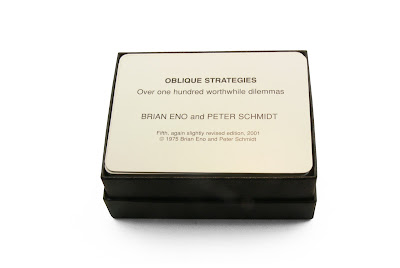"These cards evolved from our separate working procedures. It was one of the many cases during the friendship that [Peter Schmidt] and I where we arrived at a working position at almost exactly the same time and almost in exactly the same words. There were times when we hadn't seen each other for a few months at a time sometimes, and upon remeeting or exchanging letters, we would find that we were in the same intellectual position - which was quite different from the one we'd been in prior to that. The Oblique Strategies evolved from me being in a number of working situations when the panic of the situation - particularly in studios - tended to make me quickly forget that there were others ways of working and that there were tangential ways of attacking problems that were in many senses more interesting than the direct head-on approach. If you're in a panic, you tend to take the head-on approach because it seems to be the one that's going to yield the best results Of course, that often isn't the case - it's just the most obvious and - apparently - reliable method. The function of the Oblique Strategies was, initially, to serve as a series of prompts which said, "Don't forget that you could adopt *this* attitude," or "Don't forget you could adopt *that* attitude." The first Oblique Strategy said "Honour thy error as a hidden intention." And, in fact, Peter's first Oblique Strategy - done quite independently and before either of us had become conscious that the other was doing that - was ...I think it was "Was it really a mistake?" which was, of course, much the same kind of message. Well, I collected about fifteen or twenty of these and then I put them onto cards. At the same time, Peter had been keeping a little book of messages to himself as regards painting, and he'd kept those in a notebook. We were both very surprised to find the other not only using a similar system but also many of the messages being absolutely overlapping, you know...there was a complete correspondence between the messages. So subsequently we decided to try to work out a way of making that available to other people, which we did; we published them as a pack of cards, and they're now used by quite a lot of different people, I think."
- Brian Eno, interview with Charles Amirkhanian, KPFA-FM Berkeley, 2/1/80
"Unlike the Fluxus scores that Eno had used years earlier, which were essentially directives for performance, the Oblique Strategies cards were idea-generating tools and tactics designed to break routine thinking patterns. While born of a studio context, Oblique Strategies translated equally well to the music studio. For Eno, the instructions provided an antidote in high-pressure situations in which impulse might lead one to default quickly to a proven solution rather than continue to explore untested possibilities: “Oblique Strategies evolved from me being in a number of working situations when the panic of the situation—particularly in studios—tended to make me quickly forget that there were other ways of working and that there were tangential ways of attacking problems that were in many senses more interesting than the direct head-on approach.”
- Christopher Scoates, in Brian Eno: Visual Music


















No comments:
Post a Comment